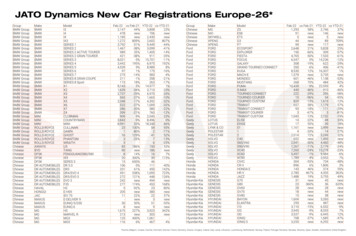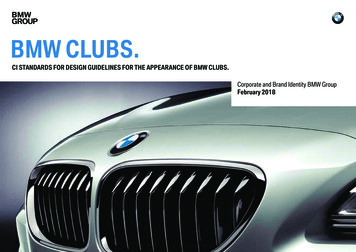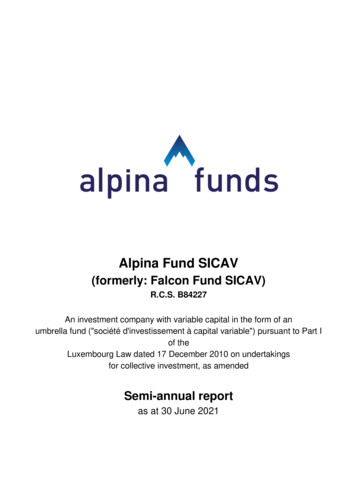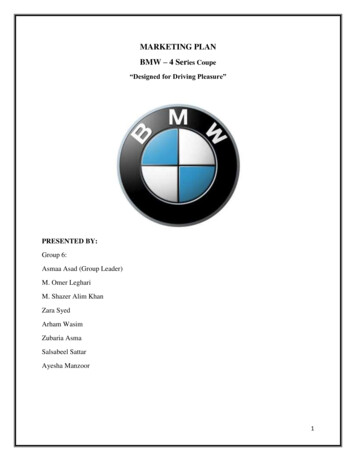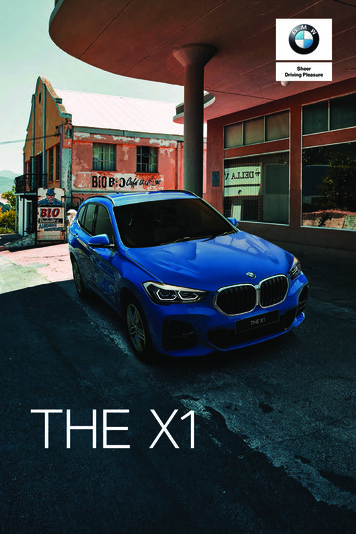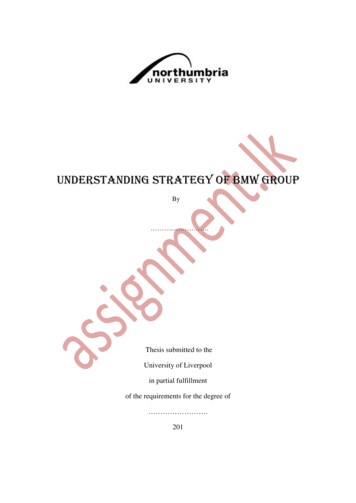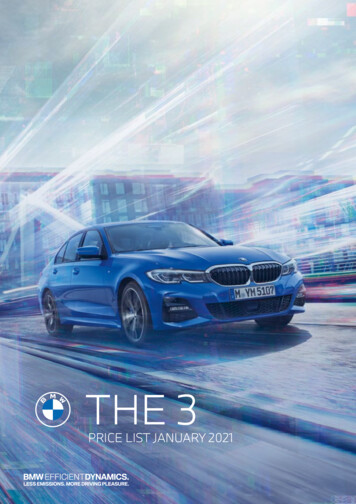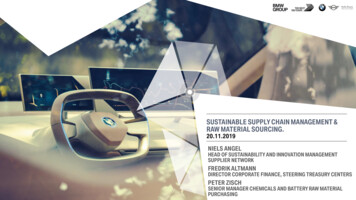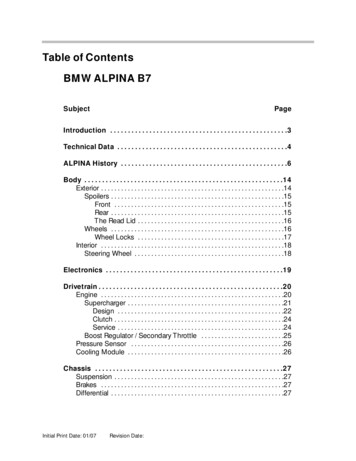
Transcription
Table of ContentsBMW ALPINA B7SubjectPageIntroduction . . . . . . . . . . . . . . . . . . . . . . . . . . . . . . . . . . . . . . . . . . . . . . . . . .3Technical Data . . . . . . . . . . . . . . . . . . . . . . . . . . . . . . . . . . . . . . . . . . . . . . . .4ALPINA History . . . . . . . . . . . . . . . . . . . . . . . . . . . . . . . . . . . . . . . . . . . . . . .6Body . . . . . . . . . . . . . . . . . . . . . . . . . . . . . . . . . . . . . . . . . . . . . . . . . . . . . . . .14Exterior . . . . . . . . . . . . . . . . . . . . . . . . . . . . . . . . . . . . . . . . . . . . . . . . . . . . . . .14Spoilers . . . . . . . . . . . . . . . . . . . . . . . . . . . . . . . . . . . . . . . . . . . . . . . . . . . .15Front . . . . . . . . . . . . . . . . . . . . . . . . . . . . . . . . . . . . . . . . . . . . . . . . . . .15Rear . . . . . . . . . . . . . . . . . . . . . . . . . . . . . . . . . . . . . . . . . . . . . . . . . . . .15The Read Lid . . . . . . . . . . . . . . . . . . . . . . . . . . . . . . . . . . . . . . . . . . . .16Wheels . . . . . . . . . . . . . . . . . . . . . . . . . . . . . . . . . . . . . . . . . . . . . . . . . . . .16Wheel Locks . . . . . . . . . . . . . . . . . . . . . . . . . . . . . . . . . . . . . . . . . . . .17Interior . . . . . . . . . . . . . . . . . . . . . . . . . . . . . . . . . . . . . . . . . . . . . . . . . . . . . . .18Steering Wheel . . . . . . . . . . . . . . . . . . . . . . . . . . . . . . . . . . . . . . . . . . . . .18Electronics . . . . . . . . . . . . . . . . . . . . . . . . . . . . . . . . . . . . . . . . . . . . . . . . . .19Drivetrain . . . . . . . . . . . . . . . . . . . . . . . . . . . . . . . . . . . . . . . . . . . . . . . . . . . .20Engine . . . . . . . . . . . . . . . . . . . . . . . . . . . . . . . . . . . . . . . . . . . . . . . . . . . . . . .20Supercharger . . . . . . . . . . . . . . . . . . . . . . . . . . . . . . . . . . . . . . . . . . . . . . .21Design . . . . . . . . . . . . . . . . . . . . . . . . . . . . . . . . . . . . . . . . . . . . . . . . . .22Clutch . . . . . . . . . . . . . . . . . . . . . . . . . . . . . . . . . . . . . . . . . . . . . . . . . . .24Service . . . . . . . . . . . . . . . . . . . . . . . . . . . . . . . . . . . . . . . . . . . . . . . . . .24Boost Regulator / Secondary Throttle . . . . . . . . . . . . . . . . . . . . . . . . .25Pressure Sensor . . . . . . . . . . . . . . . . . . . . . . . . . . . . . . . . . . . . . . . . . . . . . .26Cooling Module . . . . . . . . . . . . . . . . . . . . . . . . . . . . . . . . . . . . . . . . . . . . . . .26Chassis . . . . . . . . . . . . . . . . . . . . . . . . . . . . . . . . . . . . . . . . . . . . . . . . . . . . .27Suspension . . . . . . . . . . . . . . . . . . . . . . . . . . . . . . . . . . . . . . . . . . . . . . . . . . .27Brakes . . . . . . . . . . . . . . . . . . . . . . . . . . . . . . . . . . . . . . . . . . . . . . . . . . . . . . .27Differential . . . . . . . . . . . . . . . . . . . . . . . . . . . . . . . . . . . . . . . . . . . . . . . . . . . .27Initial Print Date: 01/07Revision Date:
BMW ALPINA B7Model: E65Production: from 11/2006 (2007 MY)After completion of this module you will be able to: Identify a BMW ALPINA B7. Explain the differences between a conventional E65 and a B7. Know what additional service is required on the supercharger.2BMW ALPINA B7
IntroductionCommitted to developing the best performing vehicles in the luxury market, BMW withALPINA has created a special high performance version of BMW’s 7 Series luxurysedan. The 2006 BMW ALPINA B7 brings together the luxury, pioneering design, andadvanced technology of the 7 Series Sedan with the scintillating performance of asupercharged, 500hp V-8 engine.To power the BMW ALPINA B7, ALPINA specially developed a higher-performanceversion of BMW’s 4.4-liter, 90-degree V-8 engine and mated it to a 6-speed automatictransmission featuring steering wheel mounted shift controls.The motor produces 500 horsepower at 5,500 rpm along with maximum torque of516 lbs.-ft. at 4,250 rpm, and propels the B7 from 0-60 mph in a mere 4.8 seconds.ALPINA 21-inch wheels carry Z-rated performance tires, while the sport-tunedsuspension includes Active Roll Stabilization.The B7 aerokit includes a rear spoiler to improve stability, handling, and performanceat high speeds.ALPINA was established in 1964 as an official and approved “ennobler” of BMWautomobiles. Their tradition is to take production BMW vehicles and make them evenmore appealing to connoisseurs of automotive finery.With this new model, BMW will raise the benchmark for the segment in terms ofperformance, refinement, technology, and luxury.3BMW ALPINA B7
Technical DataGeneralCurb weight, lb.4476Weight distribution,front/rear, %51.0/49.0Wheelbase, in.Track, front/rear, in.Length, in.Width, in.Height, in.117.762.3/62.2198.474.958.1BodyTypeDrag coefficient (CD)EPA size classification4-door sedan0.31LargeEngine & ElectricalEngine typeDOHC 32-valve (4-cam) V-8Engine featuresSupercharged & intercooled, steplessly variable induction system, Valvetronic variable intake-valve lift & DoubleVANOS variable intake- & exhaust-valve timingCylinder block & headsBore x stroke, mm/in.Displacement, cc/cu in.Compression ratioPower @ rpm, hpTorque @ rpm, lb-ft.Engine-management systemFuel requirementFuel capacity, U.S. gal.Battery capacity, amp-hr.Generator output, amp./WAluminum92.0 x 82.7/3.62 x 3.264398/2689.0:1500 @ 5500516 @ 4250Motronic ME 9.2.1Premium unleaded23.390180/2520DrivetrainDrive systemFront engine/rear driveAutomatic transmission4BMW ALPINA B7ZF 6 HP 26, 6-speed with external oil cooler, SWITCHTRONIC shift system & modified internal components
Drivetrain (Cont.)Ratios:1st2nd3rd4th5th6thReverseFinal drive 4:1ChassisBody/frame constructionUnitized all-steel structure with aluminum hood & frontfendersFront suspensionStrut-type in aluminum; double-pivot lower arms, coilsprings, twin-tube gas-pressure arms, coil springs, twintube gas-pressure shock absorbers, Active RollStabilization, aluminum subframe; ALPINA sport calibrationRear suspension4-link Integral suspension in aluminum, coil springs,twin-tube gas-pressure shock absorbers, Active RollStabilization, aluminum subframe; ALPINA sport calibrationSteering typeRack & pinion, vehicle-speed-sensitive power assist &variable ratio, with ALPINA oil coolerTurning circle, ft.39.74-wheel ventilated disc brakes:374 x 36/14.7 x 1.42 front/ 370 x 24/14.6 x 0.94 rearDiameter x thickness, mm/in.WheelsTiresCast alloy, 21 x 9.0 front/21 x 10.5 rearPerformance, 245/35ZR-21 front / 285/30ZR-21 rearDynamic Stability Control (DSC), including DynamicStability-enhancement system Traction Control, antilock braking (ABS), Dynamic BrakeControl & cornering/braking stability enhancementPerformance DataAcceleration, 0-60 mphTop speedEPA est. MPG, city/highway4.8 sec.186 mph15/235BMW ALPINA B7
ALPINA HistoryALPINA was founded by Burkhard Bovensiepen (1936 present). His passion with performance vehicles beganwith the purchase of a used Fiat 1500. Not satisfied withthe performance of the vehicle, he took it to a friend togive it a check-up and perform some tuning modifications.Burkhard and his friend added a Weber carburetor, a moreaggressive camshaft and opened up the muffler. Thisraised the horsepower from 67 bhp to 75 bhp. Shortlythereafter, a cloud of blue smoke began to follow the carand Burkhard decided to stop driving Fiat.Bovensiepen had always been interested in BMW cars, and when BMW introduced the1800 in 1963, which was more powerful than the 1500, the customers who had recently purchased a 1500 were disappointed; he saw an opportunity.The BMW four-cylinder engine had four well-designed intake ports and only one smallcarburetor, so he recognized that he could improve the performance of the car withmodification to its intake system. And with that, the first BMW-ALPINA tuning kit wascreated. The tuning kits costed 980 DM including installation and raised performance ofthe 1500 to parity with the newer 1800.BMW’s research and development department tested the ALPINA kit and they foundnothing wrong with ALPINA's work, so ALPINA got support from the factory which wasinvaluable. That support made the company’s products more desirable to BMWenthusiasts, but it also meant that installation of an ALPINA system did not void theBMW warranty.ALPINA did not receive immediate acclaim from the press. Auto motor und Sport saidthat ALPINA’s engine modifications would have have a bad effect on longevity and reliability. Bovensiepen asked Auto motor und Sport to test the car instead of just commenting on the concept of BMW tuning.That test showed that the ALPINA-1500 was equal in terms of performance of the 1800model. The ALPINA car showed no signs of stress or fragility. Auto motor und Sportwere clearly enthusiastic about the ALPINA’s performance. They also noted that thequality of the car’s fit and finish was such that it appeared to have come directly fromBMW.BMW was very impressed and when the higher-performance 1800 ti was introduced, itwas fitted with engine components identical to those developed by ALPINA.Today, the ALPINA headquarters and factory is located in Buchloe, Germany.6BMW ALPINA B7
1961Derek Bell, Harald Ertl, Niki Lauda and Brian Muir win theEuropean Touring Car Championship for ALPINA andBMW. Niki Lauda sets an absolute Touring Car record forthe six-hour race on the Nurburgring, driving the BMWALPINA Lightweight Coupé. The oil crisis rocks the motorindustry. ALPINA works through this difficult time withoutlayoffs. Two factors have a hand in this: the good reputation of the company, as well as the flexible reaction tomarket needs by a team of employees who were, alreadythen, unusually bound to their firm. ALPINA developsengines that run on regular gas – engines that are at oncefrugal and powerful1964Produced in his father‘s fine mechanical factory by theyoung business and engineering student, the enginesproduced with ALPINA dual-carburetor's receive praisenot only from the automotive press, but also from BMWand its legendary sales boss, Paul G. Hahnemann. BMWcertify the exceptional quality of these ALPINA productsby awarding BMW vehicles with the ALPINA system thefull factory guarantee1965ALPINA Burkard Bovensiepen KG is established onthe 1st of January in Kaufbeuren. The firm has eightemployees1967The name ALPINA is augmented in its profile by theunmistakable, newly-created company logo –trademark & seal of quality in one7BMW ALPINA B7
1968ALPINA engages Touring Car Motorsport – the beginningof a incomparable success story. Pilots such as DerekBell, Harald Ertl, James Hunt, Jacky Ickx, Niki Lauda,Brian Muir and Hans Stuck are found on ALPINA’s payrollbetween 1968 and 19731970ALPINA wins the European Touring Car Championship,the 24 Hours of Spa-Francorchamps, as well as all majorGerman Championships: Road Course, Hill-Climb andRallye1971ALPINA convinces BMW that a lightweight version of theBMW 3.0 CS is needed to continue to be successful inTouring Car racing. BMW tasks ALPINA with the projectleadership for the lightweight BMW 3.0 CSL Coupé. TheALPINA CLASSIC wheels in 20-spoke design were thevisual hallmarks of ALPINA’s participation in a sportsmachine officially offered by BMW1973Derek Bell, Harald Ertl, Niki Lauda and Brian Muir win theEuropean Touring Car Championship for ALPINA andBMW. Niki Lauda sets an absolute Touring Car record forthe six-hour race on the Nurburgring, driving the BMWALPINA Lightweight Coupé. The oil crisis rocks the motorindustry. ALPINA works through this difficult time withoutlayoffs. Two factors have a hand in this: the good reputation of the company, as well as the flexible reaction tomarket needs by a team of employees who were, alreadythen, unusually bound to their firm. ALPINA developsengines that run on regular gas – engines that are at oncefrugal and powerful8BMW ALPINA B7
1975With selected partners from amongst the BMW dealerbody, ALPINA begin the development of a German dealernetwork. At the same time, importerships in England andSwitzerland are established1977Dieter Quester is European Touring Car champion in aBMW ALPINA 3,5 CSL, after exciting battles with theheavily-favored Jaguar-Coupés. At the end of this successful season, ALPINA steps out of Touring Car racingfor a period of ten years, to dedicate all efforts to thedevelopment of fascinating road-going automobiles1978To wide press acclaim, ALPINA presents three automobiles at Lago di Garda in Italy, each completely developedat ALPINA. The BMW ALPINA B6 2,8 is a 3-Series BMWwith six-cylinder engine, at a time when BMW only sold 3Series with four-cylinder engines. Such high displacementin a relatively light car creates a whole new level of drivingease. The BMW ALPINA B7 Turbo, based on the 5-SeriesBMW, is the fastest saloon in the world. With 300 horsepower, the B7 Turbo Coupé establishes itself amongst themost powerful Coupés. Each of these new-generationALPINA engines have a fully-electronic computer ignition,unique at the time in the automotive world1979Burkard Bovensiepen incorporates a new businessendeavor, the ALPINA wine importership. In an impressively-short span of time, ALPINA wins over nearly all ofGermany’s top restauranteurs as clients, as well as manywine lovers. The ALPINA importership to Japan isopened, and a successful partnership begins – in 2001ALPINA delivered the 2000th BMW ALPINA to Japan9BMW ALPINA B7
1981“Auto motor und Sport” organizes the Shell KilometerMarathon, a fuel-saving challenge. The 80 mpg-car wasnot yet a topic, yet a BMW ALPINA 318i wins in classwith fuel economy of 105.72miles per Imperial gallon1983ALPINA is officially registered as an automobilemanufacturer by the German Ministry of Transport,the Kraftfahrtbundesamt1985ALPINA converts its entire automotive production toengines with catalytic converters. What’s special aboutthat? Instead of installing the more commonly usedceramic catalytic converters standard in the automotiveindustry, ALPINA are the first manufacturer to exclusivelyinstall metal catalytic converters, using EMITEC technology. Not until years later will this concept be found in otherhigh-tech automobiles1987The International German Touring Car Championshipenjoys great public interest, thanks in part to new rulesdecisively influenced by Burkard Bovensiepen. Ellen Lohr,Andy Bovensiepen, Fabièn Giroix, Peter Oberndorfer andChristian Danner, driving the BMW ALPINA M3 Gruppe A,earn multiple victories, along with many good placings.ALPINA are also pioneers in terms of the environmentimpact of racing cars – the metal catalyst debuts in theBMW ALPINA M3 Gruppe A and becomes standardequipment n every DTM race car10BMW ALPINA B7
1988Due to capacity constraints, priorities have to be drawn.The decision is taken in favor of the development and production of new BMW ALPINA automobiles. As a result,ALPINA withdraw at season's end from racing1989ALPINA create a highlight in presenting the B10 Bi-Turbo.Paul Frère, the well-known journalist and racing driver,writes in Road & Track about this automobile: "For me thisis the car I think this is the best 4-door in the world "1990ALPINA expand. The number of employees has grown inthe meantime to 120, necessitating the construction of anew, generously-dimensioned building for administrationand production1992With the advent of the BMW ALPINA B12 5,7 Coupé,ALPINA is the first automobile manufacturer to realize anelectronic clutch management system termed ALPINASHIFT-TRONIC. Foregoing use of the clutch is a breeze inlight of the six-speed gearbox' dynamic driving characteristics11BMW ALPINA B7
1993ALPINA SWITCH-TRONIC opens a new, sporty automaticdriving dimension. The combination of manual gear selection coupled to the traditional ease of driving an automaticconvinces many died-in-the-wool stick-shift drivers tomake the move to this modern automatic system. One ofthe merits of ALPINA's SWITCH-TRONIC is the ability toshift the gears using buttons on the back of the steeringwheel, much like Formula racing drivers shift their semiautomatic gearboxes1995ALPINA is the first automobile manufacturer to introduceinto series production the SUPER-CAT, an electricallyheated, metal catalytic converter, as found in the BMWALPINA B12 5.7 E-KAT. This joint project with BMW andEMITEC represents the use of a completely new emissions control technology, undercutting the 1996European emission standard by 80% with regardto HC, NOx and CO, respectively1999A new era begins: ALPINA presents a diesel automobilefor the first time in its 35-year history, the BMW ALPINAD10 BITURBO at the Geneva Salon d'Automobile - themost powerful diesel saloon in the world. The engineeringdevelopment of the super-diesel is a co-operative projectbetween BMW and ALPINA2002Based on the BMW Z8, ALPINA build the BMW ALPINAROADSTER V8 with SWITCH-TRONIC for friends of luxurious and comfortable open motoring. A limited series of555 automobiles world-wide, this exclusive model leadsALPINA to officially enter the North American market,where the ROADSTER V8 is an immediate success with450 sales. The balance of 105 found homes in Japan andEurope, warming the hearts of their owners12BMW ALPINA B7
2003With the advent of the BMW ALPINA B7, ALPINA realizea new engine concept, a mechanically-driven radial compressor – combining for the first time ever charging andVALVETRONIC – this leading to very low fuel consumption on this 500-horsepower automobile13BMW ALPINA B7
BodyExteriorThe exterior of the BMW ALPINA B7 is essentially the same as the standard productionE65. The chassis remains untouched but further refinements have been made in the following areas: Front bumper cover Rear bumper cover Rear lid spoiler Wheels Signature ALPINA pinstripes and hood/trunk badges14BMW ALPINA B7
SpoilersDue to the higher speeds that the BMW ALPINA B7 is capable of compared to thestandard production variant, extra aerodynamical elements needed to be added forstability at high speeds.FrontThe front bumper cover is made of two individual sections bonded together. The originalbumper cover is still utilized but modified onthe lower section in order to bond the signature ALPINA lower bumper cover.This serves not only to identify the vehicleas an ALPINA version of the E65, but allowsextra airflow to the cooling module assemblyand increases the downforce to the front ofthe vehicle that is needed for increasedstability at high speeds.RearThe rear bumper cover has been takendirectly from the E65 standard productionvehicle. Only a small portion where theexhaust pipe protrudes had to be modified.A finishing trim piece is then bonded andriveted on to give it a finished look.15BMW ALPINA B7
The Read LidThe rear deck lid has a spoiler attached to aid in the aerodynamics at higher speeds.WheelsThe BMW ALPINA B7 is equipped with 21”20 spoke wheels.The valve stem is concealed behind the antitheft equipped center hub cap. The air ischanneled through a hollowed out spoke onthe rim.The tire dimensions are as follow:WheelTiresFront9” x 21”245/35 ZR21Rear10.5” x 21”285/30 ZR21Valve Stem Location16BMW ALPINA B7
Wheel LocksThe BMW ALPINA B7 comes with a mechanically locking center hub cap for the wheels.In order to remove the center cap, a mechanical key is needed. A set of keys is deliveredto the customer upon delivery. All wheel locks for the vehicle are keyed the same.Wheel Lock Unlocking Procedure1. Center cap in normal position2. Press cap inward on “P”3. While pressing cap inward rotate4. Make certain tumbler is exposed5. Remove finger6. Insert Key and Remove Cap17BMW ALPINA B7
InteriorThe interior of the vehicle will be the same as offered in the regular production E65.The ALPINA specific components will be: Steering Wheel Floor Mats BMW ALPINA plaque on overhead console Door sills trim pieceSteering WheelThe steering wheel on the BMW ALPINA B7 is derived from the E60 steering wheel.The factory steering wheel is modified by ALPINA in Buchloe, Germany and adds functional microswitches located behind the steering wheel that can be used for shifting thetransmission without ever taking your hands off the steering wheel (SWITCH TRONIC).18BMW ALPINA B7
ElectronicsThe electronic system on the BMW ALPINA B7 corresponds to that of the regularproduction E65.Minor changes have been made in the programming and coding of the vehicle toaccount for ALPINA specific functions.Example:The steering wheel electronics control unit has been modifiedto identify the upshift/downshift button on the steering wheel.The transmission shift points have been changed.19BMW ALPINA B7
DrivetrainEngineThe BMW ALPINA B7 is equipped with a modifiedN62B44 engine. The engine is entirely assembled atthe ALPINA facility in Buchloe Germany to includehigher performance components such as entire pistonassemblies and front timing case covers (for supercharger mounting/oil supply).The entire engine is assembled in approximately one day. The same Master Technicianthat starts the assembly process sees it to conclusion. The final process for the technician is to stamp the identification number on the block by hand.20BMW ALPINA B7
SuperchargerThe main advantage of the ALPINA modified N62B44 engine is the use of a planetarygear driven supercharger that drives a Nautilus or Radial impeller.The ratio of the supercharger gears is 17.5:1. This indicates that with a speed of 6,000rpm, the supercharger is capable of rotating at a speed of 105,000 rpm.Because of these extreme characteristics, the tolerances on the mechanical elements ofthe supercharger are imperative.The design/concept of the supercharger was originally developed and patented by ZF.ZF was unsuccessful in utilizing the design in production because of reliability issuesdue to the metals used.ALPINA has perfected the design and materials utilized, thus allowing this type of supercharger to be utilized. ALPINA has been very successful with the design of the supercharger.21BMW ALPINA B7
DesignThe supercharger uses a planetary gearset to multiply the speed from the pulley. Theratio between the input speed and the output speed is 17.5:1 (105,000 rpm @ 6,000engine rpm!).The ring gear is driven whenever the drive clutch is engaged. The ring gear then drivesthe planetary gears that are meshed to the center sun gear.PLANETARYGEARSRING GEAR(Pulley Driven)SUN GEAR(Drives Impeller)Close-up View ofSupercharger GearsCutaway View ofSupercharger22BMW ALPINA B7
The supercharger utilizes the engine oil supply as its cooling and lubrication system.In order for the oil to be transferred to the center assembly of the supercharger, the uppertiming case cover on the 2nd bank (cylinders 5-8) had to be modified to include an oilpassage. This passage allows oil to flow through it and over to the Supercharger mounting bracket.Supercharger Mounting Bracket(Oil Passage Exposed)Note: It is extremely important that the two alignment dowel pins are installedon the support bracket. Failure to do so will result in damage to thesupercharger.The supercharger has an oil restricting orifice on the bottom mounting area. It is crucialthat this restricting orifice is installed before mounting otherwise it would result in lowengine oil pressure.Supercharger - Oil Restricting Orifice (Right)23BMW ALPINA B7
ClutchThe supercharger is not engaged while the vehicle is idling. In order to make this possible, a centrifugally engaged clutch is utilized. The clutch is fully engaged at en enginerpm of greater than 1,100 rpm.Because of the de-coupling of the supercharger at low rpm, the idle quality and fueleconomy of the BMW ALPINA B7 is improved.Bell Housing/Pulley InstalledBell Housing/Pulley Removed(Clutch Exposed)ServiceThe clutch friction material has to be checked every 60,000 miles for wear.The minimum thickness is 2 mm.Clutch Material with Springs and Weights24BMW ALPINA B7
Boost Regulator / Secondary ThrottleOne major concern during the development of the engine was to combine the Valvetronicwith a supercharging system. The Valvetronic operates with an almost neutral pressure inthe intake system (no throttle losses but 50mbar vacuum pressure to realize thecrankcase ventilation).As soon as you have a charger (it is irrelevant which system), the valvetronic won’t operate any more to save fuel.The radial compressor of the B7 runs from approximately 1,100 rpm together with theengine and provides an air flow which would increase the intake manifold pressure slowlyuntil the final pressure of 0.8 bar (overpressure).As mentioned before, the system does not work fuel savingly with more than 50 mbar atparts load. To counteract this, the boost pressure regulator (throttle in front of the supercharger) reduces the air flow to the supercharger and still keeps the vacuum pressure of50 mbar in the intake system.As soon as full power is indicated by the driver, the boost pressure regulator opens andlets the full air flow into the engine.“The opportunity we have is to close the regulator like you can put your handon a fan - the air spins around, the charger needs no power and nothing willbe damaged. No measured air has to be blown off like when you use awastegate.In other words, only the fuel which matches the measured air will be giveninto the combusting compartment and burned. That’s why the B7 is economical and powerful together.”- Axel Rimpler - ALPINA Burkard Bovensiepen GmbH Co. KG25BMW ALPINA B7
Pressure SensorAn additional pressure sensor is locatedbefore the main throttle housing (beforeintake manifold) and is used to determine the boost pressure created by thesupercharger.Cooling ModuleThe cooling module is made up of six different coolers and is mounted in the frontof the vehicle.The six coolers are: Air Intercooler Engine Coolant Radiator Engine Oil Cooler Transmission Fluid Cooler Power Steering Fluid Cooler Air Conditioning CondenserAll of the cooling modules are prepared and assembled in the ALPINA plant in BuchloeGermany and shipped to the BMW manufacturing plant in Dingolfing. The installation ofthe module is completely integrated into the manufacturing process.26BMW ALPINA B7
ChassisSuspensionThe BMW ALPINA B7 utilizes the existing 7 Series chassis but modified the hardware tomatch the higher performance level of the B7.The ARS system is standard equipment and the springs and absorbers have been tunedby a joint collaboration between BMW, ALPINA, and Michelin to make the calibrationfirmer.BrakesThe brakes have been upgraded to match the equipment on the middle easternversion 760i. These are of a larger size than on the present US version 750i.Brake Measurement Comparison (B7 vs. 750i)ModelB7750iB7750iFront374 mm348 mm36 mm30 mmRear370 mm345 mm24 mm24 mmDifferentialThe BMW ALPINA B7 uses the same differential as the 760i.This differential, although being used in theproduction of the 760i, includes “ALPINAengineered” strengthening modifications.The modifications have been integratedinto the BMW line.27BMW ALPINA B7
"Auto motor und Sport" organizes the Shell Kilometer Marathon, a fuel-saving challenge. The 80 mpg-car was not yet a topic, yet a BMW ALPINA 318i wins in class with fuel economy of 105.72miles per Imperial gallon 1983 ALPINA is officially registered as an automobile manufacturer by the German Ministry of Transport, the Kraftfahrtbundesamt 1985
